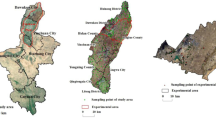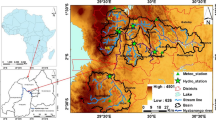Abstract
Purpose
Spatial prediction of near-surface soil moisture content (NSSMC) is necessary for both hydrologic modeling and land use planning. However, uncertainties associated with the prediction are always neglected and lack of quantitative analysis. The objective of this study was to investigate the influences of different sources of uncertainty on NSSMC estimation at two typical hillslopes (i.e., tea garden and forest).
Materials and methods
In this study, stepwise multiple regression models with terrain indices and soil texture were built to spatially estimate NSSMC on two typical land use hillslopes (tea garden and forest) at different dates. The uncertainties due to limited sample sizes used for developing regression models (uncertainty of model parameter), digital elevation model resolutions of 1, 2, 3, 4, and 5 m (uncertainty of terrain indices) and spatial interpolations of soil texture by kriging or cokriging with electromagnetic induction (uncertainty of soil texture), were investigated using bootstrap, resampling, and Latin hypercube sampling techniques, respectively.
Results and discussion
The accuracies of NSSMC predictions were acceptable for both tea garden (the Nash-Sutcliffe efficiency or NSE = 0.34) and forest hillslopes (NSE = 0.57). The model parameter uncertainty was more important on tea garden hillslope than on forest hillslope. A significant negative correlation (P < 0.05) was observed between the model parameter uncertainty and the mean NSSMC of the hillslopes, indicating that the model parameter uncertainty was small when the hillslope was wet. The resolution uncertainty from digital elevation model had a minor effect on NSSMC predictions on both hillslopes. The texture uncertainty was weak on NSSMC estimations on tea garden hillslope. However, it was more important than the model parameter uncertainty on the forest hillslope.
Conclusions
Improving the regression model structure and the hillslope soil texture mapping are critical in the accurate spatial prediction of NSSMC on tea garden and forest hillslopes, respectively. This study presents techniques for analyzing three different uncertainties that can be used to identify the main sources of uncertainties in soil mapping.










Similar content being viewed by others
References
Chen H, Zhang W, Wang K, Fu W (2010) Soil moisture dynamics under different land uses on karst hillslope in northwest Guangxi, China. Environ Earth Sci 61:1105–1111
Chirico GB, Medina H, Romano N (2007) Uncertainty in predicting soil hydraulic properties at the hillslope scale with indirect methods. J Hydrol 334(3/4):405–422
Chirico GB, Medina H, Romano N (2010) Functional evaluation of PTF prediction uncertainty: an application at hillslope scale. Geoderma 155(3/4):193–202
Cichota R, Snow VO, Vogeler I (2013) Modelling nitrogen leaching from overlapping urine patches. Environ Model Softw 41:15–26
Coleman ML, Niemann JD (2012) An evaluation of nonlinear methods for estimating catchment-scale soil moisture patterns based on topographic attributes. J Hydroinformatics 14:800–814
Deng HL, Ye M, Schaap MG, Khaleel R (2009) Quantification of uncertainty in pedotransfer function-based parameter estimation for unsaturated flow modeling. Water Resour Res 45, W04409. doi:10.1029/2008WR007477
Deutsch CV, Journel AG (1998) GSLIB-geostatistical software library and user’s guide. Oxford Univ. Press, Oxford
Famiglietti JS, Rudnicki JW, Rodell M (1998) Variability in surface moisture content along a hillslope transect: Rattlesnake Hill, Texas. J Hydrol 210:259–281
FAO/ISRIC/ISSS (1998) World reference base for soil resources. World Soil Resources Reports, FAO, Rome
Florian A (1992) An efficient sampling scheme: updated Latin hypercube sampling. Probab Eng Mech 7:123–130
Fu B, Chen L (2000) Agricultural landscape spatial pattern analysis in the semi-arid hill area of the Loess Plateau, China. J Arid Environ 44:291–303
Green TR, Erskine RH (2004) Measurement, scaling, and topographic analyses of spatial crop yield and soil water content. Hydrol Process 18:1447–1465
Hupet F, Vanclooster M (2002) Interseasonal dynamics of soil moisture variability within a small agricultural maize cropped field. J Hydrol 261:86–101
Janssen PHM, Heuberger PSC, Sanders R (1992) UNCSAM 1.1: a software package for sensitivity and uncertainty analysis. Report No. 959101004. National Institute of Public Health and Environmental Protection, Bilthoven
Jin Y, Li HP, Li JL (2007) The impact of non-point pollutant load of land-use changes in Taihu Basin. J Agro-Environ Sci 26:1214–1218 (In Chinese)
Keys R (1981) Cubic convolution interpolation for digital image processing. IEEE Trans Acoust, Speech, Signal Process 29:1153–1160
Klier C (2012) Use of an uncertainty analysis for genome-scale models as a prediction tool for microbial growth processes in subsurface environments. Environ Sci Technol 46:2790–2798
Knotters M, Brus DJ, OudeVoshaar JHO (1995) A comparison of kriging, cokriging and kriging combined with regression for spatial interpolation of horizon depth with censored observations. Geoderma 67:227–246
Lark RM (1999) Soil-landform relationships at within-field scales: an investigation using continuous classification. Geoderma 92:141–165
Lavado Contador JF, Maneta M, Schnabel S (2006) Prediction of near-surface soil moisture at large scale by digital terrain modeling and neural networks. Environ Monit Assess 121:213–232
Liao K, Xu S, Wu J, Zhu Q (2014) Uncertainty analysis for large-scale prediction of the van Genuchten soil water retention parameters with pedotransfer functions. Soil Res 52:431–442
Lin YP, Chu HJ, Wang CL, Yu HH, Wang YC (2009) Remote sensing data with the conditional Latin hypercube sampling and geostatistical approach to delineate landscape changes induced by large chronological physical disturbances. Sensors 9:148–174
McKenzie NJ, Ryan PJ (1999) Spatial prediction of soil properties using environmental correlation. Geoderma 89:67–94
Minasny B, McBratney AB, Bristow KL (1999) Comparison of different approaches to the development of pedotransfer functions for water retention curves. Geoderma 93:225–253
Nash JE, Sutcliffe JV (1970) River flow forecasting through conceptual models: part 1. A discussion of principles. J Hydrol 10(3):282–290
Nyberg L (1996) Spatial variability of soil water content in the covered catchment at Gardsjon, Sweden. Hydrol Process 10:89–103
Pachepsky Y, Radcliffe DE, Selim HM (2003) Scaling methods in soil physics. CRC Press, Boca Raton
Pachepsky YA, Guber AK, van Genuchten MT, Nicholson TJ, Cady RE, Simunek J, Schaap MG (2006) Model abstraction techniques for soil-water flow and transport. Rep. NUREG/CR-6884, Nucl. Regul. Comm., Washington, D.C
Qiu Y, Fu B, Wang J, Chen L (2001) Spatial variability of soil moisture content and its relation to environmental indices in a semi-arid gully catchment of the Loess Plateau, China. J Arid Environ 49:723–750
Qiu Y, Fu B, Wang J, Chen L, Meng Q, Zhang Y (2010) Spatial prediction of soil moisture content using multiple-linear regressions in a gully catchment of the Loess Plateau, China. J Arid Environ 74:208–220
Reedy RC, Scanlon BR (2003) Soil water content monitoring using electromagnetic induction. J Geotech Geoenviron 129:1028–1039
Saey T, Simpson D, Vermeersch H, Cockx L, Van Meirvenne M (2009) Comparing the EM38DD and DUALEM-21S sensors for depth-to-clay mapping. Soil Sci Soc Am J 73:7–12
Schaap MG, Leij FJ, van Genuchten MT (1998) Neural network analysis for hierarchical prediction of soil water retention and saturated hydraulic conductivity. Soil Sci Soc Am J 62:847–855
Sivapalan M (2003) IAHS decade on predictions in ungauged basins(PUB). Hydrol Sci J 48(6):857–880
Song X, Zhou G, Jiang H, Yu S, Fu J, Li W, Wang W, Ma Z, Peng C (2011) Carbon sequestration by Chinese bamboo forests and their ecological benefits: assessment of potential, problems, and future challenges. Environ Rev 19:418–428
Sun D, Bloemendal J, Rea DK, Vandenberghe J, Jiang FC, An ZS, Su RX (2002) Grain-size distribution function of polymodal sediments in hydraulic aeolian environments, and numerical partitioning of the sedimentary components. Sediment Geol 152:263–277
Tromp-van Meerveld HJ, McDonnell JJ (2009) Assessment of multi-frequency electromagnetic induction for determining soil moisture patterns at the hillslope scale. J Hydrol 368:56–67
van Arkel ZJ (2012) Using topographic and soils data to understand and predict field scale soil moisture patterns. Master thesis, Iowa State University
Vereecken H, Maes J, Feyen J, Darius P (1989) Estimating the soil moisture retention characteristics from texture, bulk density, and carbon content. Soil Sci 148:389–403
Webster R (1985) Quantitative spatial analysis of soil in the field. Adv Soil Sci 3:1–70
Western AW, Grayson RB, Blöschl G, Willgoose GR, McMahon TA (1999) Observed spatial organization of soil moisture and its relation to terrain indices. Water Resour Res 35:797–810
Wotling G, Bouvier C, Danloux J, Fritsch JM (2000) Regionalization of extreme precipitation distribution using the principal components of the topographical environment. J Hydrol 233:86–101
Wu S, Li J, Huang GH (2007) Modeling the effects of elevation data resolution on the performance of topography-based watershed runoff simulation. Environ Model Softw 22:1250–1260
Wu S, Li J, Huang GH (2008) A study on DEM-derived primary topographic attributes for hydrologic applications: sensitivity to elevation data resolution. Appl Geogr 28:210–223
Wu C, Wu J, Luo Y, Zhang L, DeGloria SD (2009) Spatial prediction of soil organic matter content using cokriging with remotely sensed data. Soil Sci Soc Am J 73:1202–1208
Xu Y, Gao JF, Gao YN (2011) Landscape ecological risk assessment in the Taihu region based on land use change. J Lake Sci 23:642–648
Ye M, Khaleel R, Schaap MG, Zhu J (2007) Simulation of field injection experiments in heterogeneous unsaturated media using cokriging and artificial neural network. Water Resour Res 43, W07413. doi:10.1029/2006WR005030
Zhang Y, Pinder G (2003) Latin hypercube lattice sample selection strategy for correlated random hydraulic conductivity fields. Water Resour Res 39: doi: 10.1029/2002WR001822
Zhu Q, Lin HS (2010) Comparing ordinary kriging and regression kriging for soil properties in contrasting landscapes. Pedosphere 20:594–606
Zhu Q, Lin HS, Doolittle JA (2010) Repeated electromagnetic induction surveys for determining subsurface hydrologic dynamics in an agricultural landscape. Soil Sci Soc Am J 74:1750–1762
Zong LG, Zhou J, Luo M, Lu LJ, Fei XD (2006) Analysis on current status of soil environmental quality of tea gardens in Jiangsu Province. Chin. Chin J Eco-Agric 14:61–64 (in Chinese)
Acknowledgments
This study was financially supported by the National Natural Science Foundation of China (41301234, 41571080, and 41271109) and the Natural Science Foundation of Jiangsu Province (BK20151613 and BK20151061).
Author information
Authors and Affiliations
Corresponding author
Additional information
Responsible editor: Fanghua Hao
Rights and permissions
About this article
Cite this article
Liao, K., Lai, X., Liu, Y. et al. Uncertainty analysis in near-surface soil moisture estimation on two typical land-use hillslopes. J Soils Sediments 16, 2059–2071 (2016). https://doi.org/10.1007/s11368-016-1405-6
Received:
Accepted:
Published:
Issue Date:
DOI: https://doi.org/10.1007/s11368-016-1405-6




